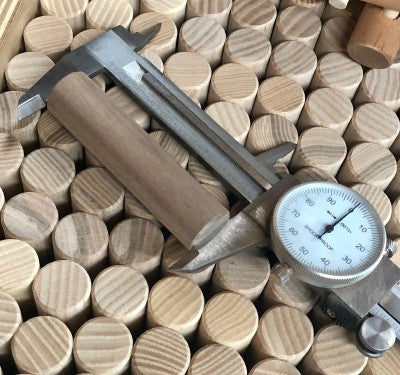The Art and Science of Puzzlemaking
Many new collectors are unaware of how stratified the quality of mechanical puzzles can be. Poorly made examples abound, and well-crafted work can be difficult to obtain This post will explain why that is the case.
The difference between a good puzzle and a bad puzzle is how it fits together and how well it was constructed. Poorly made puzzles don't fit well due to inaccuracy; unintended clues arise when ill-fitting pieces are assembled. The goal of a puzzle maker is to reveal nothing, to craft the parts of the puzzle as an almost perfect object which must be manipulated to find the truth of the solution. A precise puzzle feels the same no matter if the pieces are put together correctly or incorrectly, and gives no clues.
To achieve this every angle, every tolerance, every facet must be precisely right. Not close, not ballpark - dead on accurate. Furthermore, if a puzzle is to stand the test of time, it must be constructed using proper woodworking techniques. Simply cutting pieces and gluing them together is insufficient. Joinery must be used to strengthen the components.
Few other products made from wood require this. When building a dresser, the drawers simply need to open and close. A fine jewelry box or humidor should have a tight fitting lid, but single variables like this are relatively easy to control.
Unlike metal or other materials, wood is a unique, living substance. Each plank hides internal stresses imparted on it by the natural growth of the tree. Every time you make a cut you release some of those stresses, and the wood twists, cups or warps again. What was flat and square and precise is no longer so. You must somehow control these factors, accommodate them, work with them.
Even with the requisite skill, constant diligence is required. A tiny, unnoticed piece of sawdust in the jig can ruin an entire batch of cut parts. Dropping a box even a few inches while flush sanding the outside joints can dent a corner. Humidity can change overnight and cause an entire batch of panels to warp. The number of variables is enormous, and missing any one of them results in ruined work, costing time and materials.
This is why making quality puzzles is such an incredible challenge, and why they are not cheap. Every facet of the job must be done with precision and attention to detail. It takes years of experience and failure to find the right techniques and mindset.
Despite these obstacles, the endeavor is worthwhile. There is nothing quite like the feel of solving a precision puzzle. In today's world of abstract electronic distractions, using your hands, mind, and senses to find the truth contained within is one of life's greater rewards.

A typical budget puzzle. Note how the top is misaligned with the bottom. Furthermore, the box has been simply glued together with end grain directly attached to side grain without reinforced joinery. This is the most inexpensive and weakest joint possible; this box will fail over time due to wood movement caused by variations in temperature and humidity.
This puzzle is a Cubicdissection puzzle. Note the mitered corners to allow for full side grain gluing, and the perpendicular splines which reinforce the joint. The notched stick pieces are milled from solid material instead of being glued together. This is an example of heirloom quality work that will last indefinitely when properly cared for.




